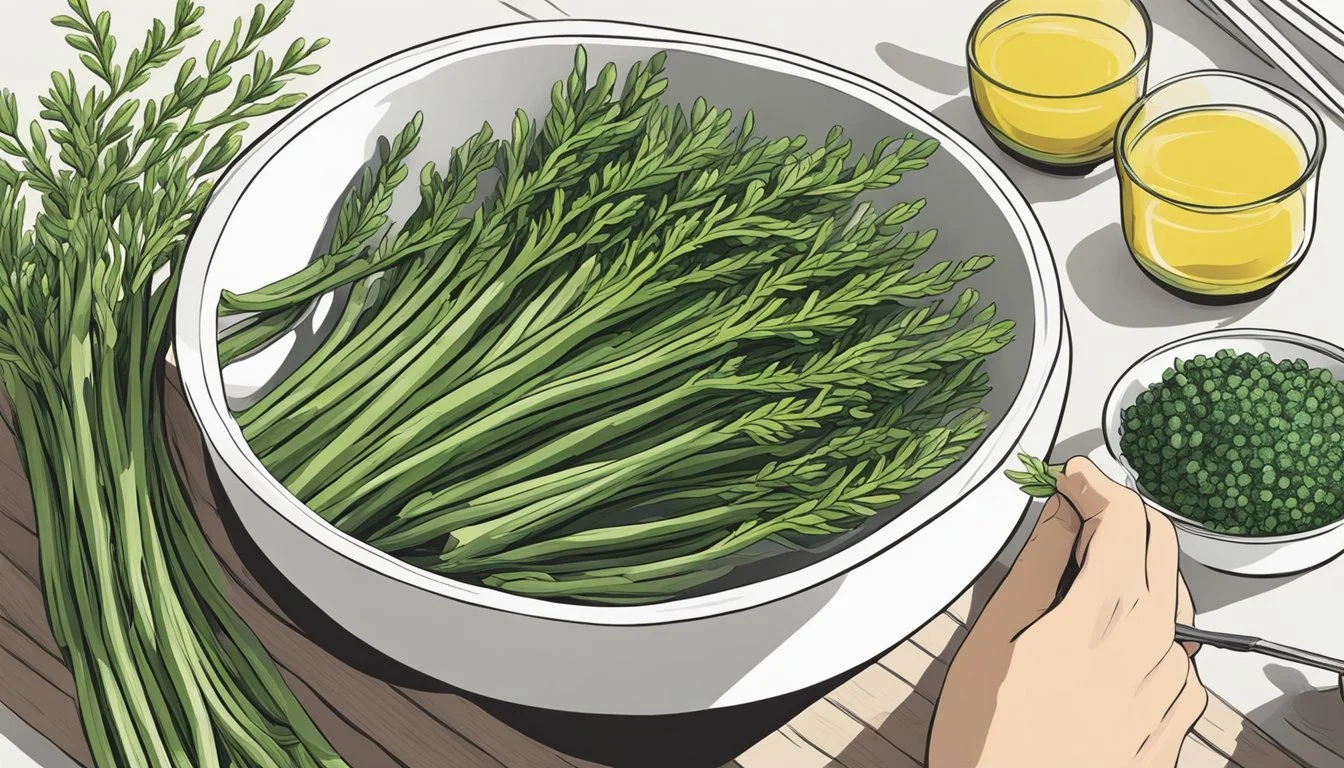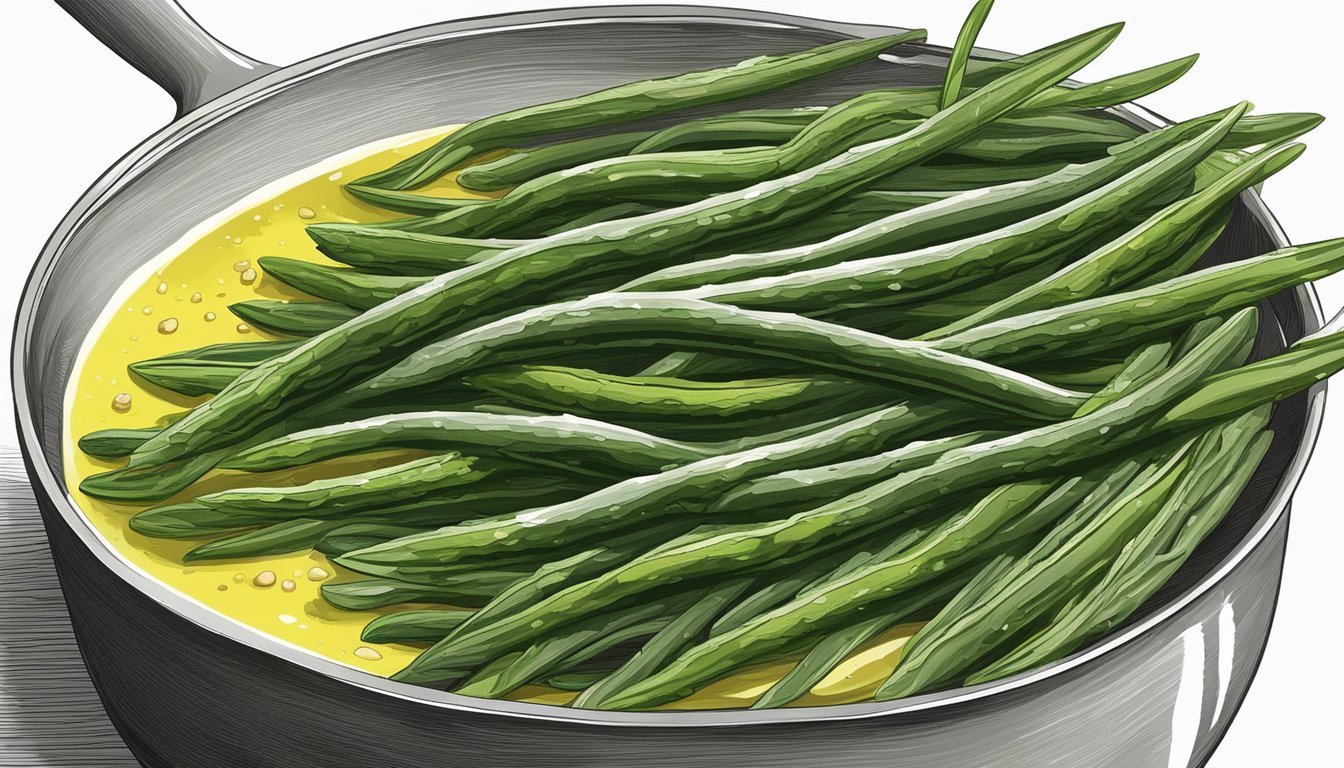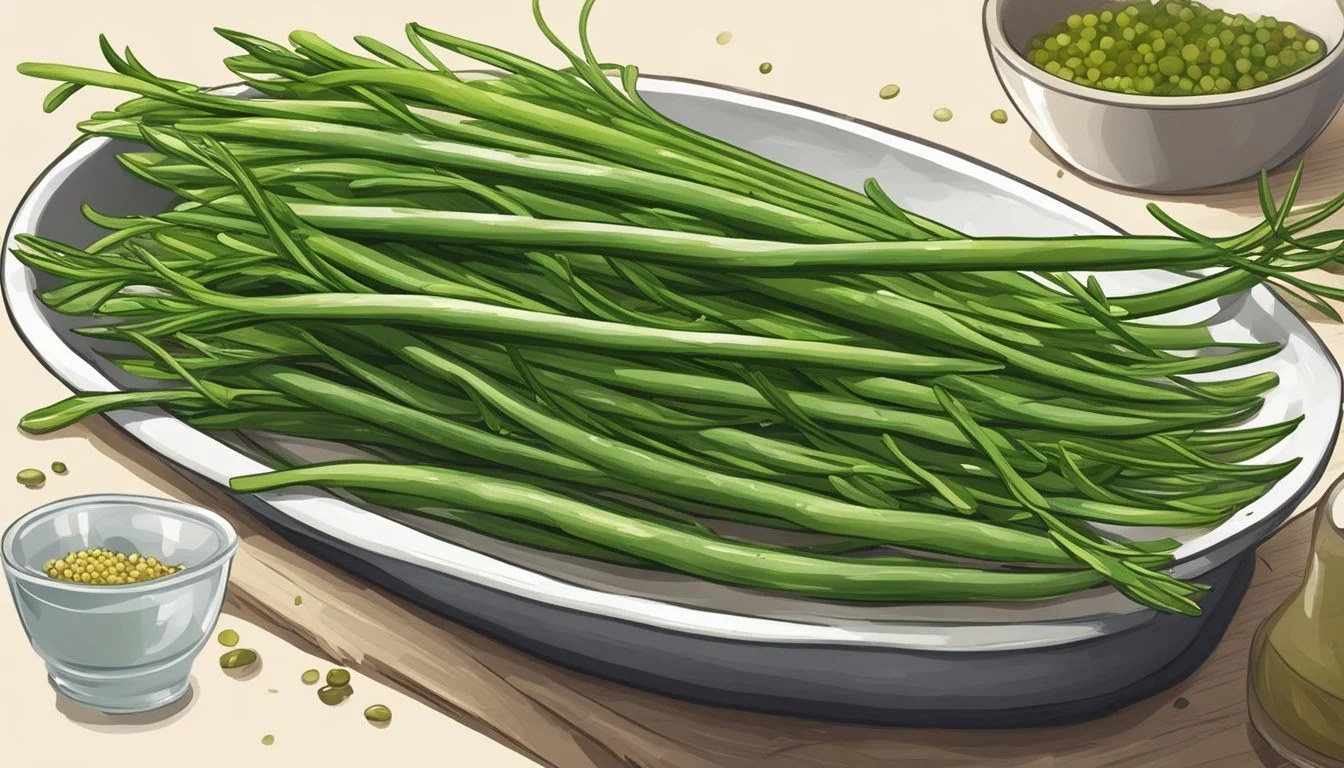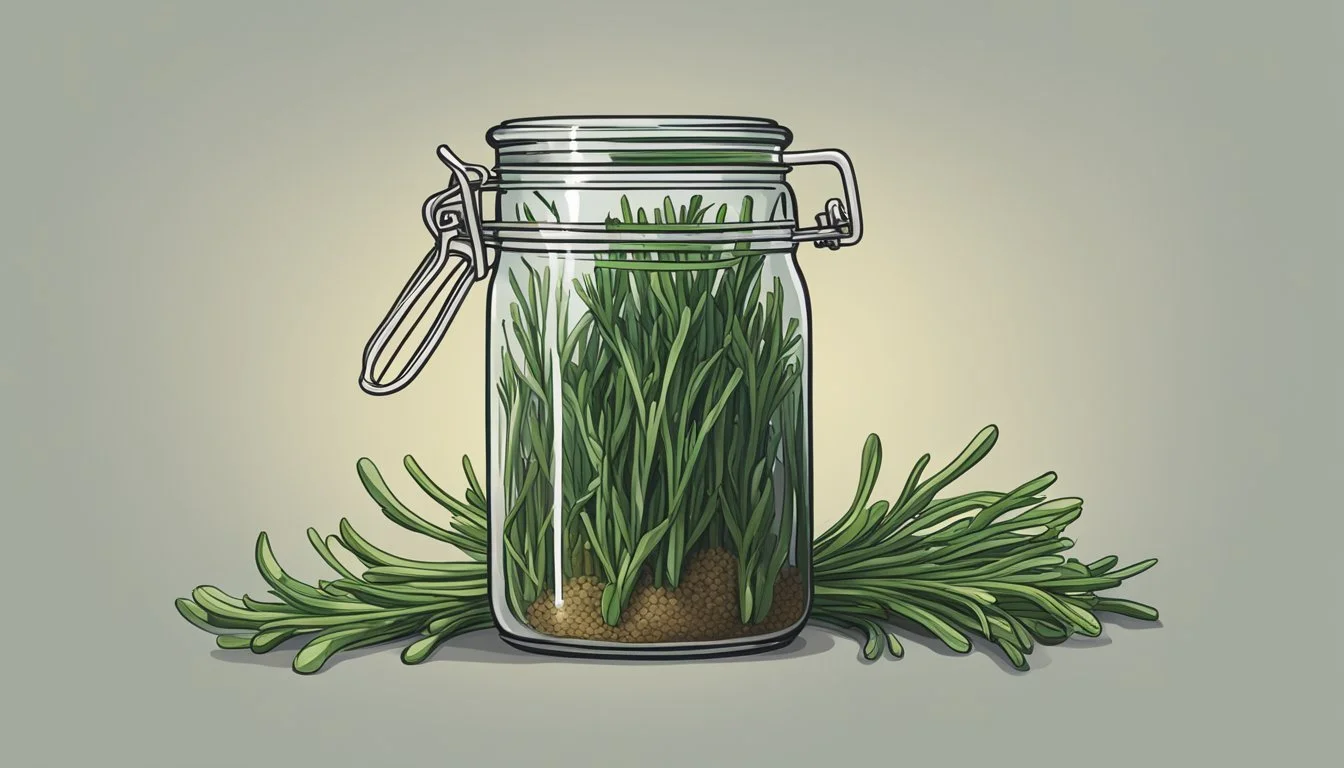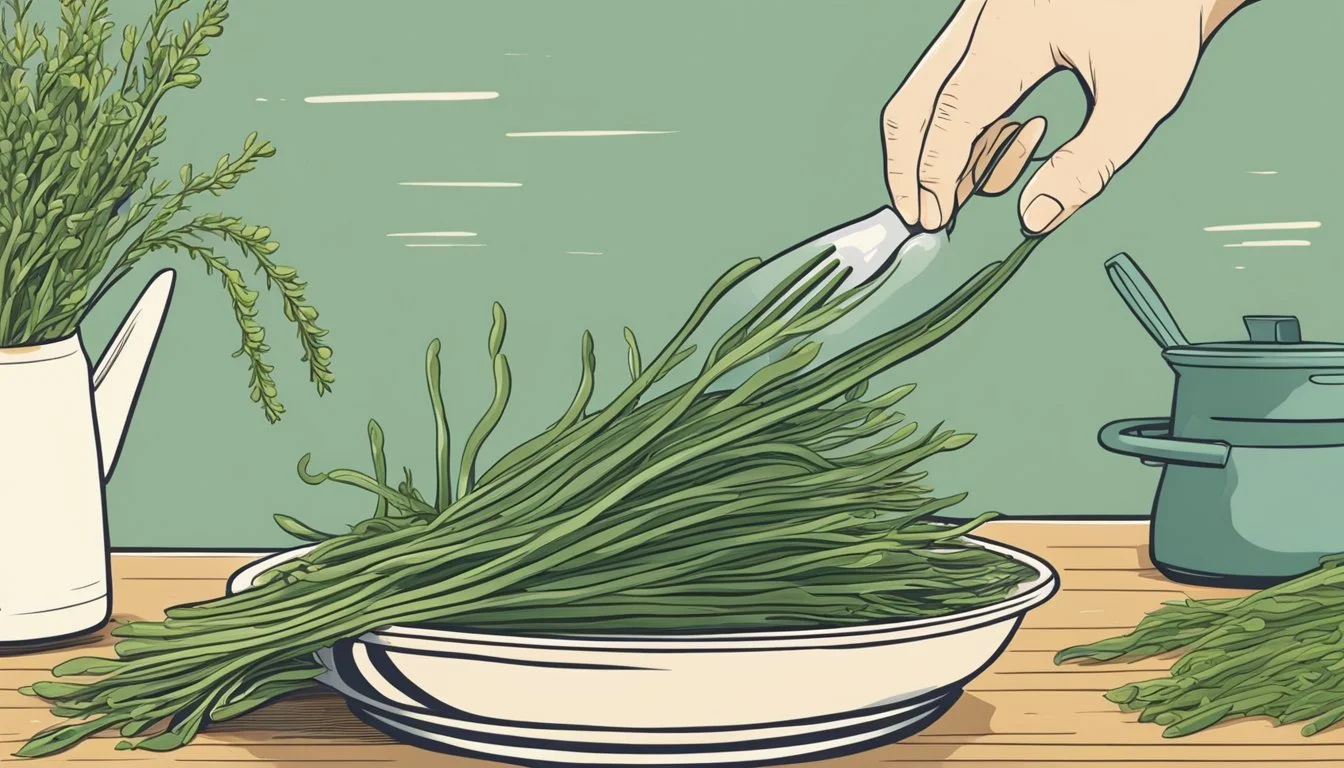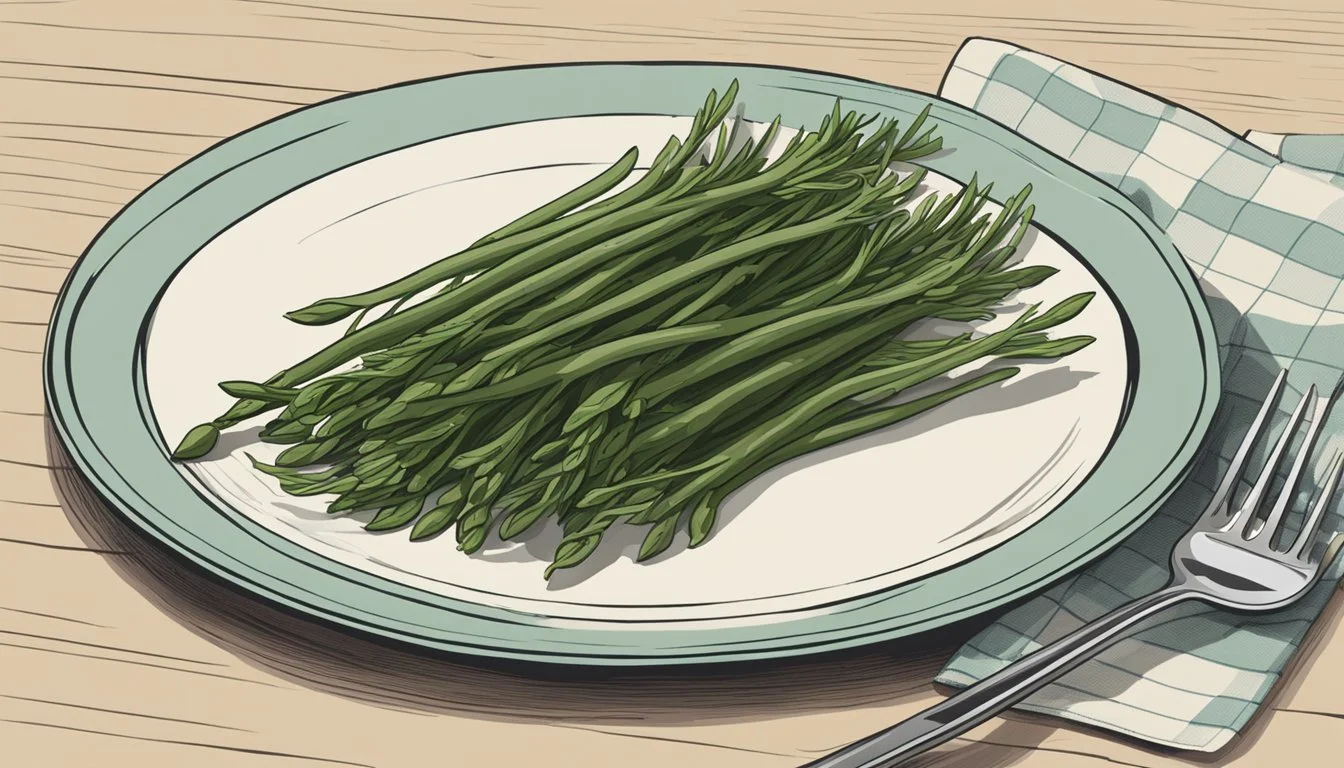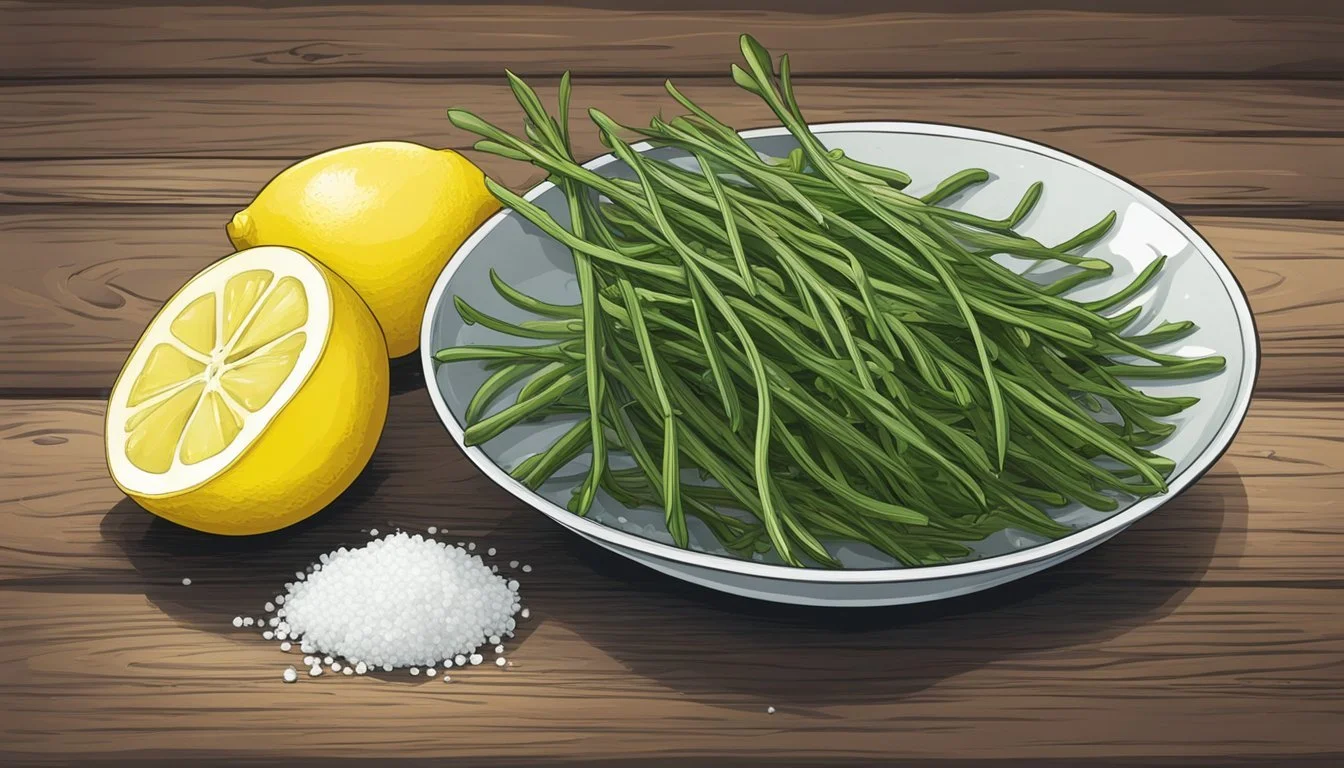How do you eat a samphire?
Unveiling the Best Techniques for Enjoying this Sea Vegetable
Samphire, a unique sea vegetable, has found its way into the culinary spotlight for its crisp texture and briny flavor reminiscent of the ocean. Often growing in coastal regions, particularly on muddy, sandy flats, this succulent is a nutritious addition to various dishes. Its appearance is similar to that of tiny asparagus (how long does asparagus last?) spears or green beans, and it serves as a suitable accompaniment to fish or as a distinctive feature in salads.
Eating samphire is straightforward; one usually consumes the tender stalks while avoiding the harder, fibrous parts. It's important to wash samphire thoroughly before cooking to remove any residual grit. Once cleaned, it can be prepared by steaming or blanching for a few minutes, a cooking process that preserves its crunchiness and vibrant color. Typically, it's best not to add salt to the cooking water since samphire naturally carries a salty flavor from its seaside habitat.
Samphire's versatility allows it to be enjoyed in simplicity, perhaps just lightly tossed with butter after cooking, as this method enhances its natural saltiness and crunchy texture without overcomplicating the taste. Its rising popularity is not only due to its distinctive taste and texture but also because of its ease of preparation, making it an approachable option for those wishing to include more sea vegetables in their diet.
What Is Samphire?
Samphire is an edible succulent plant, often associated with coastal areas, known for its crisp texture and saline flavor. It's a distinctive ingredient that provides not just taste but also a wealth of health benefits.
Typifying Samphire
Samphire refers to two main types: Crithmum maritimum (rock samphire) and Salicornia europaea (marsh samphire), also known as sea beans, or sea asparagus. Marsh samphire is more commonly found and consumed, especially in regions like the UK, and it typically grows on muddy, sandy flats. Rock samphire, on the other hand, thrives on rocky cliffs. Both varieties sport a vibrant green color and resemble miniature asparagus stalks or cacti.
Health Benefits
Samphire boasts a rich nutritional profile, being a natural source of several minerals and vitamins. It's particularly noted for its:
Vitamin C: Essential for the immune system and skin health.
Calcium and Magnesium: Key for bone health and regulating sleep.
Iron: Important for blood production and energy levels.
Additionally, samphire contains dietary fiber which supports the digestive system. Fiber helps in bulking up stool for efficient passage through the gut, also aiding in inflammation reduction. This succulent's natural saltiness means that when preparing samphire, additional salt is usually unnecessary.
Culinary Uses
Samphire is a versatile maritime vegetable that chefs prize for its crisp texture and salty flavor. It's often used to complement seafood dishes (What wine goes well with seafood dishes?) and can be a vibrant component in salads or served as a side.
Samphire in Recipes
Samphire can be prepared through blanching or steaming to maintain its crunchy texture. Blanching should be brief—for just a couple of minutes—without adding salt, due to its naturally salty taste. After blanching, it is common to toss samphire with melted butter or olive oil.
Steaming: Samphire also benefits from steaming for five to ten minutes, which preserves its nutrients and crispiness.
Cooking time: Whether blanched or steamed, samphire should be cooked no more than five minutes to prevent it from becoming too soft.
Chefs may instruct to first rinse the samphire under cold water to remove any residual sand or salt. Trimming away tough stems before cooking ensures a pleasant eating experience.
Popular Samphire Pairings
Samphire pairs exceptionally well with a variety of proteins, especially fish and meat. Here are some specific pairings:
Seafood: Fish like salmon and trout, as well as shellfish, are often served with samphire.
Meat: Lighter meats such as chicken or lamb complement the saltiness of samphire.
Pasta: Samphire can be chopped and added to pasta dishes for a maritime twist.
Salads: It can be featured raw in salads, lending a crunchy and salty component.
Some flavorful pairings include:
Butter and Olive Oil: Post-cooking, samphire is often drizzled with butter or olive oil for richness.
Citrus: A squeeze of lemon juice can help balance the vegetable's salinity.
Herbs: Herbal flavors such as dill and parsley enhance its fresh oceanic taste.
Samphire's unique flavor and texture make it a distinctive ingredient that enriches a range of culinary creations.
Preparation Essentials
Before cooking samphire, one must ensure it's properly cleaned and prepped. This section will guide the reader through the essential steps of cleaning and cutting samphire, emphasizing the removal of unwanted grit and tough parts for the most enjoyable eating experience.
Cleaning Samphire
The first step is to thoroughly wash the samphire to remove any dirt, grit, or sand that might be clinging to the stalks. This is best done under running cold water. One should carefully inspect the samphire and agitate it with their hands to dislodge any unwanted particles.
Rinse thoroughly: Under cold running water
Ensures removal of sand, dirt, or grit
Cutting and Trimming
After washing, one must cut off any roots or tough stems as they are too fibrous to eat. Samphire might also need to be broken into smaller, even-sized pieces to guarantee uniform cooking.
Remove unwanted parts: Cut off roots and tough stems with a knife.
Improves texture and edibility
Break into pieces: If necessary, for even-sized portions.
Promotes even cooking
Cooking Techniques
Samphire is best enjoyed when cooked simply to highlight its natural flavors. Below are the most effective techniques to cook samphire: boiling, steaming, and frying.
Boiling Samphire
To boil samphire, one needs only to bring a pot of boiling water to a rolling boil and then introduce the samphire. Given the vegetable's inherent saltiness, it is unnecessary to add extra salt to the water. The cooking duration is brief, typically 3-4 minutes, just until the samphire is tender but still has a bite. Afterward, it should be drained thoroughly.
Steaming Samphire
Steaming is another gentle cooking method that preserves the delicate texture and salty flavor of samphire. The process involves washing the samphire and then placing it in a steamer basket over boiling water. It should be covered and allowed to steam for 5-10 minutes until the samphire is soft.
Frying Samphire
Frying samphire in a bit of olive oil or butter is a quick way to introduce a lovely crispness to the outer texture while keeping the inside succulent. Start by heating oil or butter in a frying pan, then add the samphire, cooking it for a few minutes until it is slightly browned and crisp.
Seasoning and Enhancing Flavor
When cooking samphire, the seasoning should complement its natural saltiness while enhancing its fresh, maritime flavor. Strategic use of spices, acids, and fats can elevate the dish without overpowering the delicate samphire.
Selecting Accents and Spices
Samphire pairs well with fresh herbs and subtle spices that don't compete with its intrinsic saline taste:
Lemon: A few drops of lemon juice can brighten the natural flavors.
Garlic: Crushed or minced, garlic adds a pungent counterpoint to the greens.
Pepper: Cracked black pepper offers a spicy dimension that contrasts with the samphire's saltiness.
Vinegar: A mild vinegar can provide the necessary acidity if lemon is not on hand.
These seasonings should be used sparingly to complement, not mask, the taste of samphire.
Balancing the Saltiness
Samphire's natural saltiness may need to be balanced depending on the preparation:
Blanching: Brief blanching can remove some of the salinity and soften the texture.
Butter: Adding a small amount of melted butter mellows the saltiness and adds a rich mouthfeel.
Water content: Counterbalance the salty aspect by ensuring a good hydration level in the dish, which could be achieved by adding a sauce or dressing that isn't salt-forward.
These techniques help maintain the integrity of the samphire while achieving a harmonious flavor profile.
Harvesting and Foraging Tips
When seeking samphire, foragers must differentiate between two main types: marsh samphire and rock samphire. Each type grows in specific environments and has distinct seasons for harvesting.
Marsh Samphire
Habitat: Typically found in coastal marshes and mudflats.
Foraging Season: It is at its prime from May through August.
Identification: Characterized by succulent green stems and a vibrant appearance without branching like asparagus.
Rock Samphire
Habitat: Grows on rocky cliffs and in coastal areas.
Foraging Season: Often best harvested in May before it flowers.
Identification: Distinguished by its fleshy green leaves and a pungent, aromatic odor.
Tips for Successful Foraging
Always Positively Identify: Make sure you have accurately identified the plant before harvesting to avoid ingesting toxic species.
Sustainable Practices: Collect samphire in moderation to preserve the plant populations and the environment. Do not pull out the entire plant; instead, snip off the tips to allow regrowth.
Taste Test: Before harvesting large amounts, taste a small piece. Marsh samphire has a naturally salty flavor, reducing the need for added salt in dishes.
Permits and Regulations: Some areas require permits for foraging, so always check local regulations.
Cleaning and Preparation
Rinse Thoroughly: Both marsh and rock samphire should be washed well to remove sand, mud, or seaweed.
Remove Tough Parts: For marsh samphire, snip off the woody base before cooking like a vegetable.
Foragers should approach samphire with respect to the environment, adhering to local foraging guidelines. With care, samphire can be a delightful and sustainable addition to seasonal dishes.
Storing and Preserving Samphire
Samphire is known for its crisp texture and salty flavor, but it is also delicate and can deteriorate quickly if not stored properly. The following methods are efficient for preserving the freshness and flavor of samphire.
Refrigeration Practices
When storing samphire in the fridge, it should be wrapped tightly in a damp cloth and placed in a container or plastic bag. This helps maintain moisture and extend its freshness. It is recommended to use samphire within three days of refrigeration to ensure the best quality and taste.
Freezing Techniques
For longer preservation, freezing is an option. Prepare the samphire by blanching in boiling water for a few minutes to preserve its vibrant color and nutrients. After blanching, place it in an ice-water bath to halt the cooking process. Drain the samphire thoroughly, pat dry, and freeze it in airtight bags or containers. This can extend its life for several months.
Pickling Methods
Pickling samphire is a traditional way to preserve it and also infuse it with additional flavors. To pickle samphire:
Clean it thoroughly and trim away any tough stems.
Boil a mixture of vinegar, water, and desired spices (e.g., mustard seeds, peppercorns) to create a brine.
Place the samphire in sterilized jars and pour the hot brine over it.
Seal the jars and store in a cool, dark place.
Allow the samphire to pickle for a few weeks before consumption. Pickled samphire can be a delightful accompaniment to salads and fish dishes.
Samphire as a Garnish
Samphire, a sea vegetable with a vibrant green hue, offers a crisp texture and a taste reminiscent of the ocean. It is a unique garnish that can elevate a variety of dishes with its visual appeal and distinct flavor profile.
When fresh samphire is utilized as a garnish, it enhances the presentation and adds a touch of sophistication. Because of its naturally salty taste, samphire complements seafood dishes exceptionally well, providing a harmonious blend of sea-derived flavors.
Preparation for Garnishing:
Clean: Rinse the samphire thoroughly to remove any sand or debris.
Blanch: To soften and reduce its saltiness, briefly blanch in boiling water for 1-2 minutes.
Refresh: Immediately refresh in cold water to retain its crunchy texture.
Dry: Gently pat dry to ensure it doesn't add moisture to the main dish.
Incorporating Samphire:
As an Accent: Place a small sprig atop fish or scallops (What wine goes well with scallops?).
Diced: Finely chop and sprinkle over salads or pasta for a briny bite.
Whole Stalks: Use alongside asparagus or green beans for a visually appealing side.
Samphire should be used sparingly due to its robust flavor. A little goes a long way, and the goal is to complement the main ingredients, not overpower them.
Visual Appeal:
Color Contrast: The green color of samphire pops against lighter-colored dishes.
Shape Contrast: Its thin, twig-like shape adds texture contrast to soft or creamy dishes.
Chefs value samphire for its ability to introduce a hint of the seaside to culinary creations, making it more than just an ordinary garnish.
Health Considerations
When incorporating samphire into one's diet, individuals should be mindful of its health benefits, particularly regarding digestion, alongside certain risks and precautions they need to consider.
Digestive Benefits
Samphire contributes positively to the digestive system, primarily due to its content of dietary fiber. The fiber in samphire can bulk up stool and assist in regular bowel movements, reducing the likelihood of constipation. Moreover, the anti-inflammatory properties it possesses may contribute to reducing inflammation in the gut.
Risks and Cautions
While samphire offers various health benefits, it is high in salt which should prompt caution for those with hypertension or a salt-sensitive constitution. Overconsumption may lead to an excessive intake of sodium, counteractive to heart and liver health. Individuals with thyroid issues should consult healthcare professionals before excessive consumption due to its iodine content, which can affect thyroid function. Additionally, no scientific evidence suggests samphire has any effect on cancer or tumor prevention or treatment, thus it should not be relied upon for such health concerns.
Purchasing and Availability
Samphire is most commonly found in coastal regions of the UK and parts of Europe. It typically grows in marshy, saline environments. The peak season for fresh samphire is during the summer months, usually from June to August, when it's at its most tender and flavorful.
When looking to purchase samphire, shoppers can commonly find it at:
Supermarkets: Larger chains may stock packaged samphire in the produce section during its season.
Grocery stores: Local and specialty shops often offer samphire when it's seasonally available.
Farmers' markets: These provide the freshest options since samphire can be directly sourced from local growers.
Fishmongers: Being a traditional accompaniment to seafood, it's often sold where fresh fish is available.
To ensure freshness, the samphire should appear vibrant green and firm, not limp or yellowed. It's also preferable to consume samphire shortly after purchase, as it doesn't have a long shelf life. If you find samphire out of season, it may be available in pickled form, which has a longer shelf life and can be found in specialty stores.
Availability can vary based on location, but generally, in the UK, samphire is becoming more widely available due to its popularity as a culinary delicacy.
Source Availability Supermarkets Seasonal Grocery stores Seasonal Farmers' markets Fresh, seasonal Fishmongers With seafood
Consumers should be aware that while samphire can be found outside the summer season, its quality and flavor may not be optimal.
Cultural and Historical Context
Samphire, also known by terms like glasswort, sea beans, or marsh samphire, holds a significant place both culturally and historically. This succulent plant, thriving in the saline marshes and rock-strewn coastlines, has been a component of local diets for centuries.
Throughout history, it has been gathered and consumed primarily in the regions where it grows naturally, such as the United Kingdom and parts of Europe. Traditionally, samphire was not only seen as a food source but also used in the production of soap and glass, hence the name "glasswort".
In terms of popularity, samphire has seen a resurgence in modern cuisine, appreciated for its crisp texture and natural saltiness, enhancing the flavors of various dishes. It's often associated with coastal culture where fresh seafood is complemented by samphire’s unique taste.
Samphire in Diverse Cultures:
United Kingdom: Especially important in British culinary practices, where it is often served with fish or as part of a sea-themed dish.
European Cuisine: Commonly featured in French and Spanish cooking, symbolizing the connection to the sea.
Cultural Significance:
Symbolizes sustainability and local foraging.
Represents a connection to the sea and coastal life.
The historical practices surrounding samphire, including its gathering and culinary use, have cemented its role as a cultural marker for coastal communities. Its endurance as a popular ingredient reflects a blend of historical tradition and modern culinary innovation.
Reader Queries and Comments
In the journey of exploring how to eat samphire, many readers have shared their experiences and sought advice.
Question: Is it necessary to remove the roots and tough stems of samphire?
Response: Yes, it is recommended to remove any roots and tough stems, as they tend to be tough and not as enjoyable to eat.
Feedback: A reader remarked, "After boiling samphire for just two minutes, it retained its crunch and was a perfect side dish." This quick-cooking method seems to resonate well with many who prefer samphire with a bite.
Comment: One diner's experience noted, "The natural saltiness of samphire pairs excellently with unsalted butter." This seems to be a common sentiment, suggesting that additional salt may not be necessary.
Below is a summary of key points raised by the community:
Inquiry Type Community Notes Cooking Time Typically 2-5 minutes in boiling water or steam until soft. Seasoning Avoid adding salt; samphire provides a natural saltiness. Preparation Remove tough parts; rinse well to remove grit and excess salt.
They have also expressed curiosity over alternative cooking methods. Here are a couple:
Steaming is as effective as boiling and can retain more nutrients.
Sauteing quickly in a pan with a bit of oil can create a different texture and flavor profile.
Through these exchanges, it is clear that enthusiasts enjoy samphire's unique taste and appreciate simple cooking techniques that highlight its natural flavors.
Conclusion
Samphire is a nutritious and flavorful vegetable that adds a unique touch to a variety of dishes due to its salty and succulent characteristics. Whether one opts for marsh or rock samphire, it is usually prepared by blanching or steaming, allowing its natural flavors to shine without the addition of salt to the cooking water.
Here are quick pointers for their consumption:
Wash thoroughly to remove sand or dirt.
Trim away any tough stems or roots.
They can be served as a side dish, often just with a knob of butter.
For a crisp finish, roast with a little oil for 8-10 minutes at 200°C (400°F).
Because samphire is already rich in natural sodium, it pairs well with fresh flavors and ingredients that do not overpower its distinct taste. Cooking time is generally short, retaining the vegetable's crunchy texture.
When eating samphire, culinary explorers should note that it fits particularly well with seafood and can enhance the essence of a fish dish. However, individuals with hypertension or cardiovascular concerns should be mindful of the sodium content, adjusting their intake accordingly.
With these considerations, samphire stands as a versatile vegetable—one that can be enjoyed simply or as part of a more complex ensemble on the plate.

